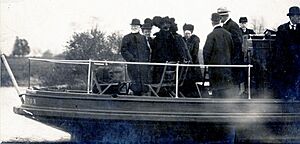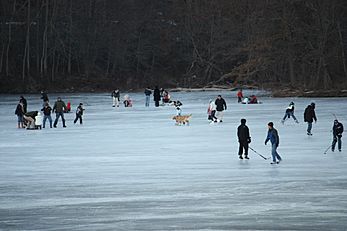Lake Carnegie (New Jersey) facts for kids
Quick facts for kids Lake Carnegie |
|
|---|---|

The lake, with Princeton University's Cleveland Tower in the background
|
|
| Location | Mercer / Middlesex counties, New Jersey, US |
| Coordinates | 40°22′13.39″N 74°37′17.57″W / 40.3703861°N 74.6215472°W |
| Type | Reservoir |
| Primary inflows | Millstone River |
| Primary outflows | Millstone River |
| Basin countries | United States |
|
Lake Carnegie Historic District
|
|
| Lua error in Module:Location_map at line 420: attempt to index field 'wikibase' (a nil value). | |
| Location | Roughly bounded by Lake Carnegie shoreline from Conrail bridge at W end to dam W of Kingston at E end, Princeton, New Jersey |
| Area | 262 acres (106 ha) |
| Built | 1906 |
| Architect | Pennington Satterthwaite (boathouse) |
| Landscape architect | Howard Russell Butler |
| Architectural style | Mission Gothic |
| NRHP reference No. | 90001000 |
| Significant dates | |
| Added to NRHP | June 28, 1990 |
Lake Carnegie is a large reservoir (an artificial lake) in Princeton, New Jersey. It was created by building a dam on the Millstone River. The Delaware and Raritan Canal runs along its eastern side.
A famous businessman and philanthropist (someone who gives money to good causes) named Andrew Carnegie paid for the lake's construction. He then gave it to Princeton University. In 1990, the area around the lake was recognized as a historic place. It is now called the Lake Carnegie Historic District.
Even though the lake is privately owned by Princeton University, it is open for public use. Many people enjoy ice skating, fishing, and picnicking there. Fish you might find include largemouth bass, carp, pickerel, crappie, and channel catfish. Sometimes, rainbow and brown trout swim into the lake from Stony Brook.
The lake is very important for Princeton's rowing team. It is also a training spot for the US Olympic rowing team. You might have even seen an aerial view of Lake Carnegie in the opening of the TV show House M.D.
Contents
Building Lake Carnegie: A Gift to Princeton
Before Lake Carnegie was built, Princeton's rowing team used the narrow Delaware and Raritan Canal. This waterway was busy with commercial boats, making it hard for the rowers. The team wished for their own lake, but they didn't have a plan to build one.
In 1902, a former team member, Howard Russell Butler, was painting a portrait of Andrew Carnegie. During their talks, Carnegie mentioned the many lakes he had built in his home country of Scotland. Butler shared the rowing team's dream of a lake in Princeton.
Carnegie became very interested in the idea. He asked Butler to find out how much it would cost and if it was possible. After checking with an engineering company, Butler told Carnegie it would cost about $118,000.
Buying the Land for the Lake
Carnegie visited the university to see the proposed site. Soon after, he gave Butler permission to start the project. In 1903, a group of Princeton alumni (former students) began buying farmland in the area where the lake would be. They then sold this land to Carnegie. This was done quietly so that local residents wouldn't suspect anything and the land could be bought at the best price.
By 1905, all the necessary land was purchased. Workers then began clearing the area and building the bridges and the dam.
The Lake's Grand Opening
The official opening ceremony for Lake Carnegie took place on December 5, 1906. Andrew Carnegie arrived by train with many friends. He was met by university president Woodrow Wilson and others. Carnegie and Wilson led a parade into Alexander Hall. Students, who had been given the day off, cheered loudly for Carnegie.
At one point, a group of students even sang a special song:
-
Carnegie, Carnegie
He is giving us a lake
You can hear the breakers break;
Carnegie, Carnegie
Andy, Andy, you're a dandy
Carnegie.
Carnegie returned to Princeton the next spring to watch the lake's first regatta (a series of boat races). President Wilson reportedly tried to get another donation from Carnegie. Carnegie replied, "I have already given you a lake." Wilson's famous reply was, "We needed bread and you gave us cake."
Environmental Challenges and Solutions
Lake Carnegie has faced some environmental issues over the years. Because it was not very deep at first, flooding and siltation became problems. Siltation is when mud, sand, and other fine particles are carried by water (like from Stony Brook) and settle at the bottom, making the lake shallower.
Another problem was sewage from nearby towns. The towns grew quickly, but their water treatment facilities did not keep up. This led to pollution in the Millstone River and then in the lake.
Keeping the Lake Clean
To deal with these issues, the lake has been dredged (cleaned by removing mud and silt from the bottom) three times. The first time was in 1927, then in the late 1930s, and most recently in 1971. The 1971 dredging made the lake a uniform depth of nine feet near the shoreline.
In 2002, the United States Environmental Protection Agency said Lake Carnegie was "impaired." This means the lake could not fully support all its intended uses. The pollution comes from many sources, including litter, chemicals like fertilizers and pesticides, car waste (oil and gas), and even goose droppings. Because of unsafe levels of mercury in the lake, people are advised not to eat too much fish caught there.
Many local volunteer groups are working hard to improve the water quality in Lake Carnegie and the streams that flow into it. Their efforts include removing litter, testing water samples, and teaching people about water safety.
Images for kids
-
The boathouse, home to Princeton Rowing and the US Olympic rowing team








